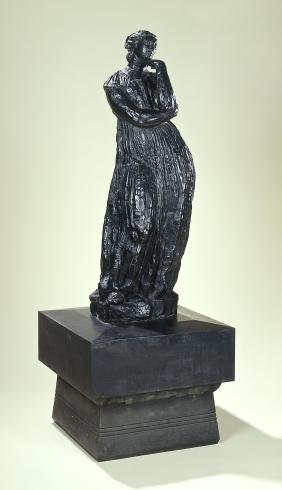Between 1905 and 1912, Bourdelle devoted himself to the figure of Penelope, wife of Odysseus, who waited faithfully for her husband to return. He created three versions in different sizes, with slight variations.
The work owned by the Petit Palais is a medium-sized version, without a spindle and with one foot extended. It is the second example of the medium-sized Penelope, probably cast between 1924 and 1946.The genesis of the work can be found in several silhouette sketches in the Musée Bourdelle of his student and future second wife, Cléopâtre Sévastos, contemplating a work of art in a London museum.One of them is poetically entitled Sévastos in front of the Hindu god and is dated August 1906. However, Penelope’s face owes much to his first wife, Stéphanie van Parys.
Penelope reflects different influences at work in Bourdelle’s sculptures since 1900. She owes her pose with twisted hips, known as contrapposto, and her caryatid draperies to Ancient Greece and she has the posture of a tanagra, those ancient statuettes which were popular with collectors at the turn of the last century. She has the fullness of figure of Indian statues which Bourdelle admired greatly. Her curves are reminiscent of 14th century Parisian Gothic virgins. These academic references are applied to a very modern form of construction with geometric planes and an unusual pedestal, which is almost cubist in style, rooting it firmly in the modern era.
A. S.

City of Paris municipal collection's website
The collections portal can be used to search the collections of Paris’s 14 municipal museums (approximately 336,000 works, including 43,000 belonging to the Petit Palais).
It is also possible to download around 12,000 images of the museum’s works free of charge.
Access the Museums of the City of Paris collections portal
Extern databases
Discover a selection of databases online presenting works from the Petit Palais or documents concerning the history of the museum.

